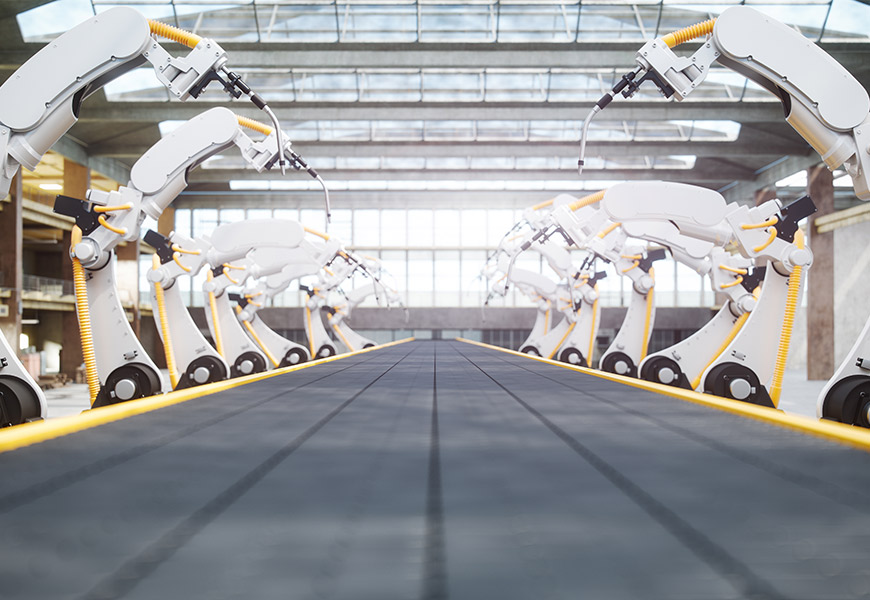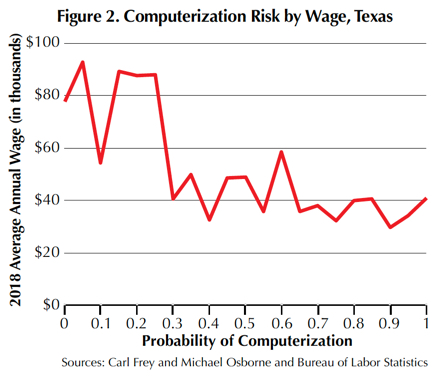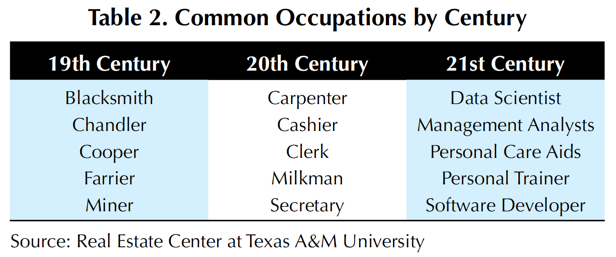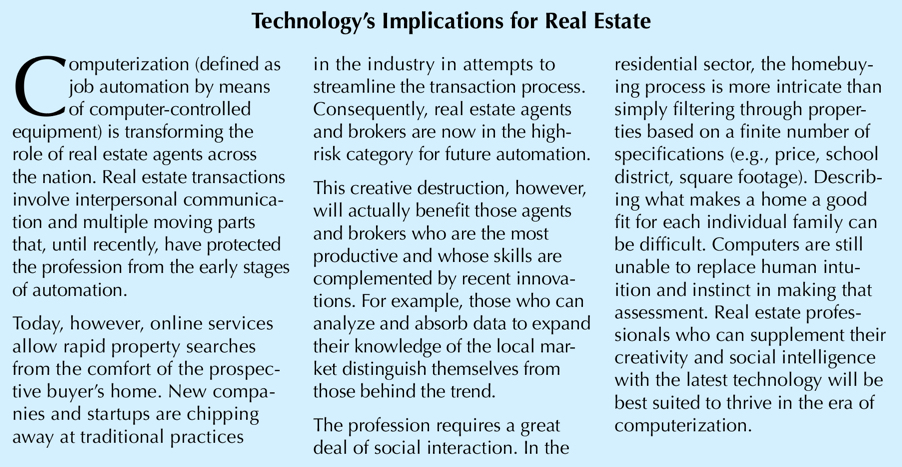
Robot Revolution

Rapid technological change threatens more than half of Texas’ current employment, but increased productivity is a net benefit on employment and standards of living in the long run. |
Robot: A machine capable of carrying out a complex series of actions automatically.
Once reserved for dystopian literature, the infiltration of robots in human life has never been more apparent. Virtual assistants (e.g., Apple’s Siri and Amazon’s Alexa), autonomous vacuum cleaners, and self-driving cars are no longer fantasies of the future. While the reality of the robot revolution is rosier than ominous prophecies of the past, not all of the consequences are well understood.
Industrial mechanization and increased computing power disrupted production processes across the globe during the 1990s. The technology of that era enabled the automation of well defined, repetitive “routine tasks." Routine tasks can be both cognitive and physical in nature. For example, mathematical computations and record keeping are analytical exercises, while sorting and stacking activities require manual labor. All of these tasks, however, involve methodical repetition of a constant procedure.
The integration of computers into production processes transformed Texas’ employment distribution. Productivity increases complimented high-skill occupations by making tasks more efficient, elevating both employment and earnings. Rising salaries increased the opportunity cost of household tasks (e.g., cooking and cleaning) while providing more income for recreational and leisure activities. Consequently, the demand for lower-skill service occupations increased.
Service occupations (not to be confused with the broader service-providing sector) often require interpersonal communication or task-flexibility. For example, a janitor must be able to maneuver through rooms, open doors, climb stairs, and pick up and discard items, as well as identify areas that need cleaning. These basic actions require little skill and education but are highly variable and thus difficult to automate.
As with high-skill jobs, productivity growth made middle-skill jobs more efficient; but instead of complementing labor, technology typically replaced it. Struggling to overcome a widening skills gap, workers who were replaced often fell into service occupations. In essence, skill-based technology change polarized the labor force through expansions of both high- and low-skill jobs at the expense of middle-skill employment (Table 1).

The employment transition of the 1990s was augmented by globalization and the reduction of free-trade barriers. Many of the middle-skill jobs that were not automated were offshored to capitalize on cheaper labor. As with automation, globalization complemented high-skill labor, which in turn increased the demand for low-skill service jobs. The aggregate impact of these efficiency gains was positive for Texas, where consumers enjoyed lower prices and maintained global competitiveness in its leading industries (e.g., oil/gas extraction, trade/transportation, and manufacturing). However, employment disruptions occurred even in these successful sectors as market forces adjusted. The Great Recession facilitated further labor-market pangs by adding cyclical pressure to already elevated levels of frictional unemployment.
While the labor market struggled, technology continued to evolve, leading to a new phase of automation: the Robot Revolution. The current wave of mechanization increasingly involves the completion of complex tasks previously reserved for humans. For example, autonomous vehicles are nearly indistinguishable from their human-operated counterpart—a futuristic illusion a little over a decade ago. Another example is voice recognition and response by virtual assistants who seem to learn and become smarter every day
The striking feature of today’s robots is their ability to execute nonroutine tasks. Driving through traffic or holding a conversation requires a great deal of flexibility to respond to changes in the surrounding environment. Judgment is required when making a left turn across oncoming traffic or determining which voice to listen to in a crowded restaurant.
The Robot Revolution is likely to be as disruptive (if not more) than the previous period of mechanization. The determinant of automation is no longer “routineness" but “programmability." Programming involves organizing the components of a task into a well defined algorithm, similar to an instruction manual readable by computers. A programmer must specify the robot’s actions and reactions to each possible scenario. In the robot’s eyes, these scenarios come in the form of data.
Advancements in machine learning, data mining, and other branches of artificial intelligence enabled the collection of massive data sets, or Big Data, necessary to program complex tasks. Consider optical character recognition (OCR) technology that allows transcriptions of handwritten or typed materials. Once transcribed into a standard text format, search functions can filter through billions of pages for the specified content. The usefulness of OCR depends on its ability to accurately decipher patterns (words). This accuracy improves as the quantity and variety of its sample text (data) expands. Big Data is the driver of computerization and robotics.
Employment Implications
Newly developed technologies are threatening occupations that were previously immune to automation. Half of total Texas employment is categorized as at high risk for computerization within the next few decades (Figure 1). Most of the state’s labor force is concentrated at the two ends of the distribution. The high-risk jobs are predominantly the low-wage service occupations that expanded during the previous phase of mechanization (Figure 2). Many of these jobs require customer interaction, which had spared them from automation. These interactions, however, do not require high levels of social intelligence. For example, a cashier may facilitate a transaction while hardly speaking to the customer after a courtesy greeting. This is a regular occurrence and is socially acceptable. Consequently, cashier jobs are at high risk to be automated as firms impliment self-check-out processes that mimic these interactions.

The probability of computerization can also be viewed as a timer, predicting how soon a job will be automated. Occupations at high-risk represent those for which substitutable technology is already developing and being perfected. Given the large proportion of the state’s employment in this category, labor-market adjustments are expected to continue in the foreseeable future. The share of employment with probability of computerization between 0.2 and 0.6 is substantially lower than the tails of the distribution. This suggests an eventual slowdown of technological disruption. Essentially, robots will take the low-skill jobs but be unable to replace more intellectual or socially demanding occupations.


Automation Anxiety and the Future
Automation anxiety is a centuries-old concern that has reignited fears of widespread unemployment, but the features that prevailed in other periods of rapid transformation still exist today. Productivity growth directly benefits workers whose skills complement the new technology, pushing up earnings and employment. Higher efficiency decreases prices for the rest of the economy, while workers have additional income to spend on other industries.
The more important and less obvious feature is how innovation creates new industries and demand for human labor (Table 2). This component is overshadowed by the immediate threat of technological unemployment, but all of today’s jobs are spawned from yesterday’s innovations. Predicting jobs that will be created decades from now is impossible, so people naturally focus on those that may be lost today. Future occupations are lined up to replace those made irrelevant by innovation, but no one knows what they are at present. For example, the introduction of computers into the workforce replaced many clerks and typists, but it opened up a plethora of new occupations, resulting in exponentially higher employment. Many 19th century jobs require a dictionary to be understood today, while 21st century occupations would have been equally unintelligible as recently as 30 years ago.

There is no guarantee, however, that this phase of innovation will propagate into greater employment opportunities. But instead of fearing progress, society should embrace it and facilitate a smoother transition. Investing in high-skill development through re-education and training programs can reduce the skills gap and better position workers to complement new technologies. The skills and tasks least likely to be computerized are those involving creativity, social intelligence, problem solving, and abstract thought. These fundamentally human characteristics are not programmable, and, therefore, are out of the reach of robots.

____________________
Dr. Torres ([email protected]) is a research economist, Miller ([email protected]) a research associate, and Van a research intern with the Real Estate Center at Texas A&M University.

You might also like

Publications
Receive our economic and housing reports and newsletters for free.





